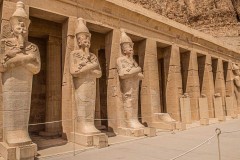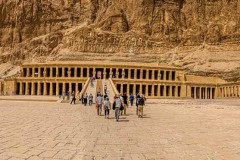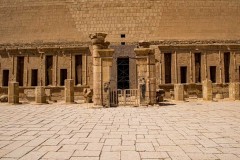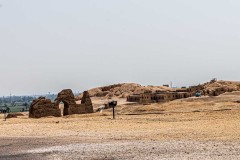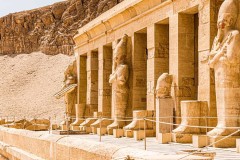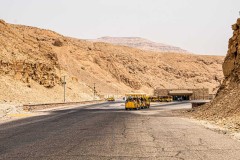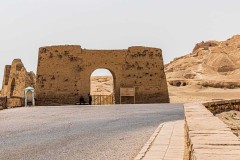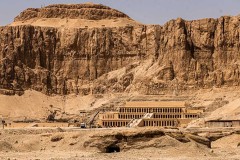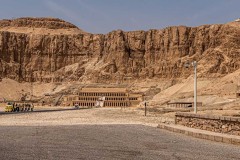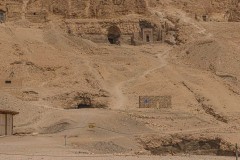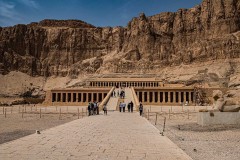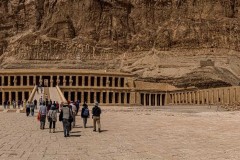The Temple of Hatshepsut is an ancient Egyptian temple located on the west bank of the Nile River in Luxor, Egypt. It is also known as the Temple of Deir el-Bahri and was built during the 18th dynasty by the pharaoh Hatshepsut, who was one of the few female pharaohs of Egypt.
The temple was built as a mortuary temple to honor the pharaoh Hatshepsut and her father, the god Amun. It was designed by the architect Senenmut and was constructed using sandstone, limestone, and granite. The temple consists of three levels, each connected by ramps and staircases.
The first level of the temple is dedicated to the god Amun and contains a large courtyard with a colonnade of columns. The second level is dedicated to the pharaoh Hatshepsut and contains a large sanctuary, an audience hall, and several smaller chambers. The third level is the highest and contains a chapel dedicated to the god Ra-Horakhty.
The temple is famous for its unique architecture, which combines Egyptian and Greek styles. It also contains many reliefs and statues depicting the pharaoh Hatshepsut and her accomplishments, including her expeditions to Punt, a land rich in exotic goods.
The Temple of Hatshepsut is considered one of the greatest examples of ancient Egyptian architecture and is a popular tourist destination in Egypt. It was also declared a UNESCO World Heritage Site in 1979.
Temple of Hatshepsut history
The Temple of Hatshepsut was built during the reign of the pharaoh Hatshepsut in the 15th century BCE. Hatshepsut was one of the most successful pharaohs of the New Kingdom period of ancient Egypt and ruled for approximately 22 years. She was known for her building projects, including the construction of the Temple of Hatshepsut.
The temple was built as a mortuary temple, which was a type of temple dedicated to the pharaohs and their families for use as a funerary complex. It was designed by the architect Senenmut, who was also a close advisor to Hatshepsut. The temple was built on the site of an earlier temple, which was constructed during the Middle Kingdom period.
The construction of the Temple of Hatshepsut was a massive undertaking, requiring the labor of thousands of workers. It was constructed using sandstone, limestone, and granite, which were transported from quarries located throughout Egypt. The temple was designed with three levels, with each level connected by ramps and staircases.
The Temple of Hatshepsut was not only a mortuary temple, but it also served as a center for the cult of Amun, the primary god of ancient Egypt. The temple was dedicated to Amun, and many of the reliefs and statues within the temple depict the god.
After Hatshepsut’s death, her successor, Thutmose III, attempted to erase her memory from history by defacing many of the reliefs and inscriptions within the temple. However, the temple remained a popular site of pilgrimage throughout the New Kingdom period and beyond.
Today, the Temple of Hatshepsut is one of the best-preserved ancient Egyptian temples and is a popular tourist destination in Egypt. Its unique architecture and intricate reliefs and statues make it an important historical and cultural landmark.
Temple of hatshepsut facts
Here are some interesting facts about the Temple of Hatshepsut:
- The Temple of Hatshepsut is one of the most impressive examples of ancient Egyptian architecture, and it was built during the 18th Dynasty, which is considered to be the Golden Age of Egypt.
- The temple is located in Deir el-Bahri, on the west bank of the Nile River, near the Valley of the Kings, and it is surrounded by steep cliffs.
- The Temple of Hatshepsut was dedicated to the goddess Hathor, who was the patron goddess of Thebes, and to the god Amun.
- The temple was built to honor the pharaoh Hatshepsut and her father, the god Amun, and it was designed by the architect Senenmut.
- The temple is made of limestone and sandstone, and it has three levels, with each level connected by ramps and staircases.
- The Temple of Hatshepsut is decorated with intricate reliefs and statues that depict the pharaoh’s expeditions to Punt, a land rich in exotic goods.
- The temple was used as a place of worship and pilgrimage for over a thousand years after its construction.
- The temple was damaged by an earthquake in ancient times and was later restored by the Roman emperor Septimius Severus in the 3rd century AD.
- The temple was rediscovered by a team of archaeologists led by the French Egyptologist Jean-Francois Champollion in the early 19th century.
- The Temple of Hatshepsut is considered one of the most important historical and cultural landmarks in Egypt and was declared a UNESCO World Heritage Site in 1979.
temple of hatshepsut architecture
The Temple of Hatshepsut is considered one of the greatest examples of ancient Egyptian architecture. Here are some of the key architectural features of the temple:
- The temple is built into the cliffside and has three levels, with each level connected by ramps and staircases. The temple’s design is based on the traditional Egyptian temple layout, with a large courtyard at the front leading to a hypostyle hall and a sanctuary at the back.
- The temple is made of limestone and sandstone, and the different levels are distinguished by different colors of stone. The first level is made of red sandstone, the second level is made of white limestone, and the third level is made of yellow limestone.
- The temple’s colonnaded terraces are one of its most distinctive features. The colonnades on the second level are decorated with reliefs and statues depicting the pharaoh Hatshepsut, as well as scenes from her expeditions to Punt.
- The temple’s hypostyle hall is one of the largest in Egypt and is supported by 32 massive columns. The columns are decorated with reliefs and inscriptions depicting the pharaoh and the gods.
- The temple’s sanctuary is located at the back of the temple and is accessed through a series of ramps and corridors. The sanctuary contains a statue of the god Amun, which would have been worshipped by the pharaoh and her priests.
- The temple is decorated with intricate reliefs and statues depicting the pharaoh Hatshepsut, her accomplishments, and her relationship with the gods. The reliefs are notable for their attention to detail and for their use of different colors to create a sense of depth and perspective.
- The temple’s overall design is a blend of traditional Egyptian temple architecture and elements of Greek architecture, such as the use of columns and pediments. This fusion of styles was typical of the New Kingdom period and reflects the influence of Egypt’s trading partners and neighbors.
The importance of Temple of Hatshepsut
The Temple of Hatshepsut is an important historical and cultural landmark in Egypt for several reasons:
- It is one of the best-preserved examples of ancient Egyptian architecture, and it showcases the innovative and sophisticated building techniques of the ancient Egyptians.
- The temple is a testament to the reign of the pharaoh Hatshepsut, who was one of the few female pharaohs in ancient Egypt. Hatshepsut was a successful ruler and undertook numerous building projects throughout Egypt.
- The temple’s intricate reliefs and statues depict Hatshepsut’s accomplishments and her relationship with the gods. The reliefs also depict scenes from Hatshepsut’s expeditions to Punt, which was a land rich in exotic goods.
- The Temple of Hatshepsut was a center of worship for the god Amun, who was the most important god of ancient Egypt. The temple’s construction was intended to honor Amun and to ensure the pharaoh’s eternal afterlife.
- The Temple of Hatshepsut has been the subject of extensive archaeological study and restoration, providing valuable insights into ancient Egyptian history and culture.
- The temple’s location on the west bank of the Nile, near the Valley of the Kings, underscores the importance of this region as a center of royal and religious activity in ancient Egypt.
- The Temple of Hatshepsut is a popular tourist destination in Egypt and draws visitors from around the world, contributing to the country’s economy and cultural heritage.
Visiting Hatshepsut’s Temple, Luxor
Visiting the Temple of Hatshepsut is a popular activity for tourists visiting Luxor, Egypt. Here are some tips for planning your visit:
- Opening Hours: The temple is open daily from 6 am to 5 pm. It is recommended to visit early in the morning or late in the afternoon to avoid the crowds and the heat.
- Entrance Fees: There is an entrance fee to visit the Temple of Hatshepsut, and the fee is separate from the fee for the Valley of the Kings. You can buy tickets at the entrance or through your tour operator.
- Guided Tour: Hiring a licensed guide is recommended to fully appreciate the history and significance of the temple. Guides are available at the entrance, and you can negotiate the price before starting the tour.
- Dress Code: It is recommended to wear comfortable and modest clothing, covering your shoulders and knees, as a sign of respect for the temple’s religious significance.
- Sun Protection: The temple is located in the desert, and the weather can be extremely hot, especially during the summer months. It is recommended to wear a hat, sunglasses, and sunscreen to protect yourself from the sun.
- Photography: Photography is allowed in most areas of the temple, but some areas may have restrictions. It is recommended to ask your guide before taking photos.
- Accessibility: The Temple of Hatshepsut is not fully accessible for people with mobility issues. There are many stairs and uneven surfaces, so it is recommended to check with your guide or the temple staff for any specific accessibility needs.
- Souvenirs: There are many souvenir shops near the temple, where you can buy traditional Egyptian handicrafts and souvenirs. It is recommended to bargain for the best price.
- Surroundings: The Temple of Hatshepsut is located in a beautiful natural setting, surrounded by desert cliffs and the Nile River. It is recommended to take some time to appreciate the stunning views and the peaceful atmosphere of the temple’s surroundings.


